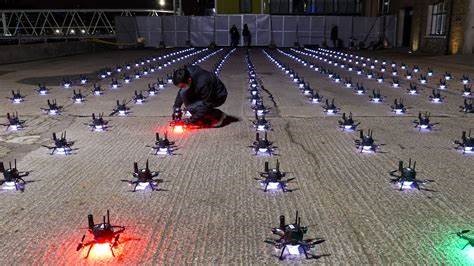What Makes Drone Light Shows Special? For civilian use, drones are most commonly used in filming and photography. In contrast, light show drones are somewhat different, focusing on basic components such as LED lights, batteries, satellite navigation systems like GPS, and antennas. Most current light show units use quadcopter drones.
Due to their simple structure, these drones are usually lightweight. For example, Intel’s Shooting Star drone, designed specifically for light shows, weighs 330 grams and is primarily made of plastic and foam. According to Cyberdrone, a light show specialist in the UAE, a drone that is too light can be easily affected by strong winds at high altitudes, but if it is too heavy, it will take longer to take off, land, and position, reducing its agility during performances.
In addition to the main component, which is the LED light capable of turning on, off, and changing colors flexibly, other components such as GPS, antennas, and sensors help the drone position itself accurately, reducing the risk of collisions during joint operations.
Another important factor is the battery. “Battery life is the main factor determining the length of the performance.” Battery capacity is also proportional to weight. Currently, most light show drones have a battery life of 10-15 minutes, excluding takeoff and landing time.
The number of drones in each show depends on the complexity of the content, but typically requires a minimum of 100-150 devices.
How Are Drones Set Up? After determining the context and script ideas, designers and engineers will build 3D versions of the expected images. Each drone will perform its own flight mission. Before the show, each drone will be loaded with a program detailing its flight plan from takeoff to landing. Some professional software even allows for the simulation of the entire virtual performance on a computer to assess potential risks before performing in real life.
Once in flight, drones operate automatically, so they need to be precisely calibrated to reduce the risk of collisions and fly in the correct position. The unit stated that they use software like Houdini, Blender, or Cinema 4D, then develop a program containing information about spatial coordinates, time, and the colors that the LED lights will display at different time frames.
Additionally, to have a large number of drones operate together, “swarm” control technologies like Swarm are applied to allow drones to communicate with each other to maintain distance. They use integrated satellite navigation system data to prevent collisions.
Organizers will apply technologies like RTK (Real-Time Kinematics) from ground control stations, updating data in real-time to ensure drones continuously perform their tasks without deviating from their course.
Despite thorough preparation, not all drone shows are successful. An organizing unit in Perth (Australia) suffered a loss of USD 100,000 when 50 devices fell for unknown reasons during a performance in 2022. In August 2023, hundreds of drones simultaneously fell during a show at a zoo in Guangdong (China). In July 2023, a show in Brisbane (Australia) had to be canceled when 350 out of 500 devices fell into the river, forcing the organizers to retrieve them to reduce pollution risks from the batteries.

